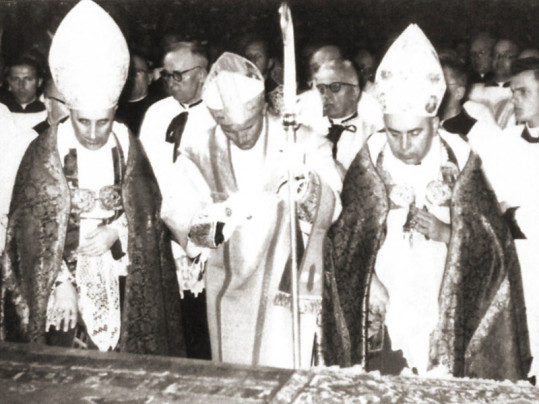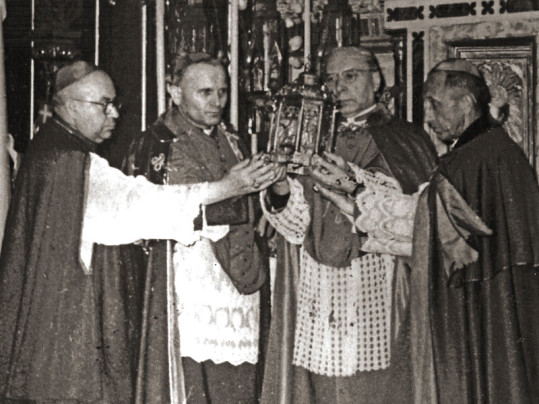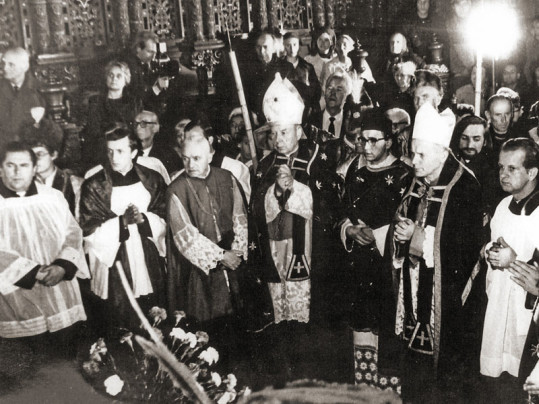Pope John Paul II was particularly attached to Wawel Cathedral. The Bishop, and later Cardinal Wojtyła visited the cathedral an innumerable number of times. Four decisive moments in his life were connected with the Cathedral. Karol Wojtyła, then an ordinary priest, celebrated his first Holy Mass at the neo-Romanesque altar in St Leonard’s Crypt on the 2nd of November, 1946 . The Mass was for the intention of his deceased parents and brother. Wojtyła was consecrated bishop on the 28th of September, 1958, St Wenceslaus Day, a patron of Wawel Cathedral,. He was installed here as archbishop on the 8th of March, 1964, and later as cardinal on the 9th of July, 1967.
On the Easter Sunday or a Sunday during the Christmas season, Wojtyła invited parishes he had visited during the year to the cathedral. He also invited young people on the occasion of the Christ the King day. He tried to make people of his diocese aware that the cathedral is its very heart and spared no effort to make sure the cathedral fulfilled its mission of “the mother of all churches”.
- Anointment of Karol Wojtyła as bishop, 1958.
After his election to the Holy See, Pope John Paul II wrote about Wawel Cathedral in a letter addressed to the Cracow Cathedral Chapter: “here strikes the heart of Poland and my heart is striking here too”.
John Paul II’s great attachment to this site were seen in his visits to Wawel Cathedral during each of his apostolic visits to Poland in 1979, 1983, 1987, 1991, 1997, 1999 and 2002.
He particularly venerated St Stanislaus, the patron saint of Poland, and Blessed Queen Jadwiga, who was canonised by the Pope in 1997.
The famous procession of St Stanislaus from Wawel to Skałka on the 8th of May was restored due to the efforts of Karol Wojtyła, then the archbishop of Cracow. In the year of the Millennium of the Baptism of Poland (1966) he invited the entire Polish Episcopate with Primate Cardinal Wyszyński to Kraków. The procession was the culmination of the Millennium events in Cracow.
As early as a couple of days after his election to the Holy See (23rd of October, 1978), during his audience for Poles, John Paul II expressed his wish to come to Poland on the jubilee of the 900th anniversary of St Stanislaus’ martyr’s death which fell in May 1979. However, the communist authorities did not give their consent to his visit on that date, so he came to Wawel in June. It was his first pilgrimage to Poland. Then, in 1979, Pope John Paul II expressed his particular attachment to Wawel Cathedral: “My first steps upon arrival to Cracow are directed to this Cathedral, to meet with you, who are awaiting me here, at the grave of St Stanislaus, of Blessed Queen Jadwiga, at the graves of our kings, leaders and national poets. You all know more than well what Wawel Cathedral has been and what it is for me”. Two days later, on the 900th anniversary of the death of St Stanislaus, on the 8th of June, 1979, Pope John Paul II celebrated the Holy Mass at the grave of the saint.
- The celebration of the Millennium of the Baptism of Poland at Wawel Cathedral, 1966.
Next to the altar of St Stanislaus, the second most important place in the Cathedral, at which Wojtyła used to pray, is the altar of Christ Crucified, connected with the worship of St Jadwiga, the Queen of Poland. During his third pilgrimage to Poland in 1987, Pope John Paul II celebrated the Holy Mass at the relics of Blessed Queen Jadwiga, whom he canonised ten years later on Cracow Błonia common during his sixth pilgrimage to Poland.
Most of mementoes of John Paul II are on display at the Cathedral Museum, of which he was the initiator and patron. In 2008, a monument of John Paul II was built in front of Wawel Cathedral.
- Repeated funeral of Kazimierz IV Jagiellon and his wife Elizabeth celebrated by Primate Cardinal Stefan Wyszyński and Cardinal Karol Wojtyła at Wawel Cathedral, 1973



